Ian Berry creates melancholic urban scenes, often depicting a lonely or less glamorous side of city living. Even at touching distance, many viewers don’t realise that they are looking at many layers, and shades, of denim jeans.
His success has been seen in many countries, giving a chance for people to see the work in person. With a number of sell-out solo shows in London and Sweden, he has also shown across Europe and the States, including the home of the modern jean, San Francisco.
Ian has been written about in major media in all corners of the globe leading to him being named as one of the top 30 under 30 artists in the world by Art Business News Magazine.
In this interview, Ian talks about his current exhibition Behind Closed Doors. We discover how this body of work came about, the process of putting it together and what drew him to denim in the first place.
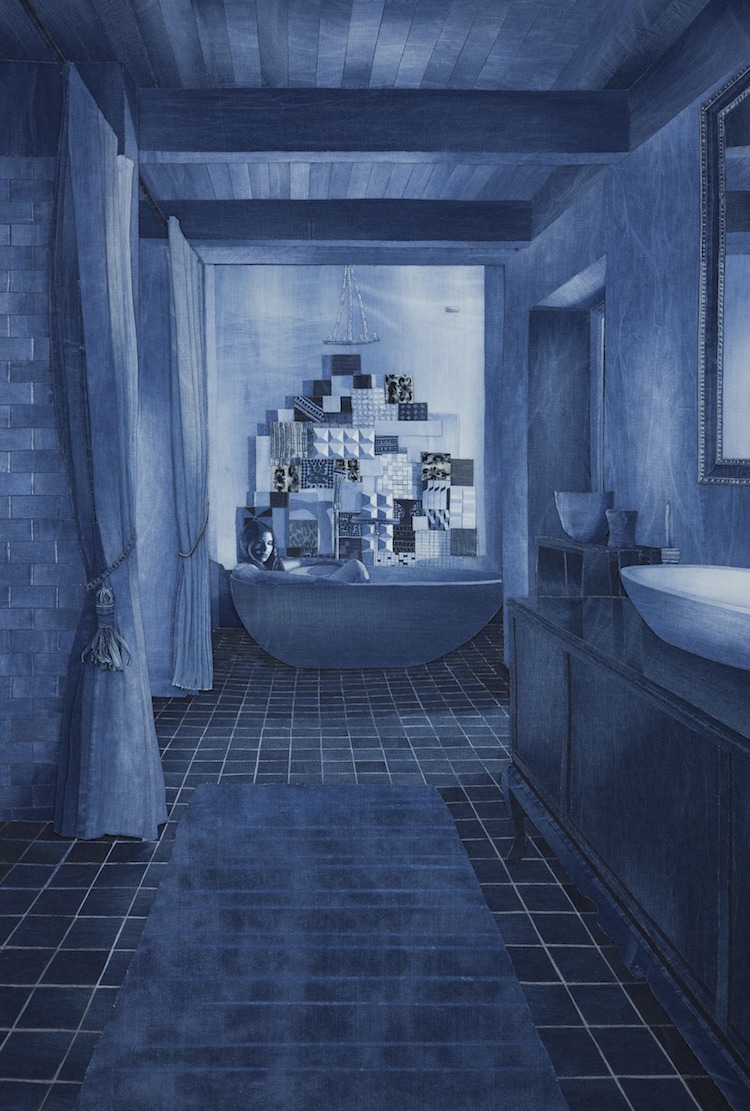
A creative and fascinating world
TextileArtist.org: What initially attracted you to textiles as a medium?
Ian Berry: In total truth, I came in through the back door. I knew very little about textile art, or artists, before starting with this over a decade ago. That changed quite quickly over the years, however, to learn so much more, and it genuinely excites me and I’ve been so humbled to see what amazing work is out there.
However, I would say my way to come back to art was more the urban art/street art culture at the beginning of the millennium. It really excited me and motivated me to start creating again. I loved the attitude they had. In fact, have liked the crossover between both the rising urban art and fiber art.
I have really have fallen for so many artists working with textiles. To mention just a few Mark Evans work with leather is just another level. Ben Venom, Erin M Riley and Chris Roberts are killing it and my friend Luke Haynes Quilting is truly great and he has a great energy about himself. Shezaad Dawood is an inspirational artist and the texture in his work is as beautiful as his layered narratives.
Discovering these and countless others has been very inspiring, and dare I say, surprising. I may be hated for saying this, but I grew up thinking textile art was something done in the WI, now I think it is the most creative and fascinating thing ever.
It was specifically the denim that I was attracted to and I think it stands for so much, which I will go into later.
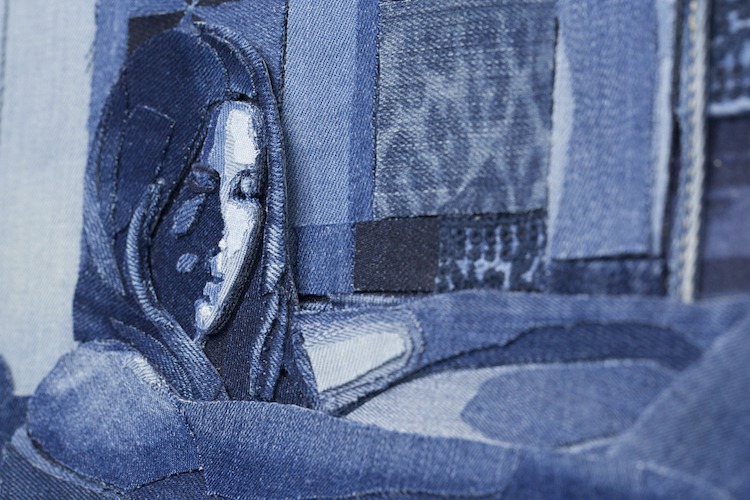
What or who were your early influences and how has your upbringing influenced your work?
I was a pretty normal kid, living in a small village, most people knew each other’s business, the girls go to dancing class, the boys play football. A nice little place on the edge of Huddersfield and ‘Last of the Summer Wine’ Country. But I would always draw, and would say I was probably known for it as ‘the arty one’.
I think I was like 13 or 14 and my dad took me to Saltaire, Bradford to Hockney’s gallery and that was really motivational. I remember coming away with a Lichtenstein book, one of Warhol, and of course one from Hockney. ‘What, a guy who came from near where I lived, look at what he is doing and he now lives in America’, I thought. He became an early icon of mine and is still to this day.
It’s a question I could make a book about I think but I would say my life has directly influenced Behind Closed Doors, it started out as I wanted to investigate what the home was. I had gone a period where I moved every two years, first to Buckinghamshire, then into London, Sydney via backpacking, then Sweden where I spent five years before coming back to London, after a stint in Amsterdam.
I really was in a spin and wondered where home was – but not only that, especially as I was looking at London, seeing the home is no longer a home, it’s an asset.
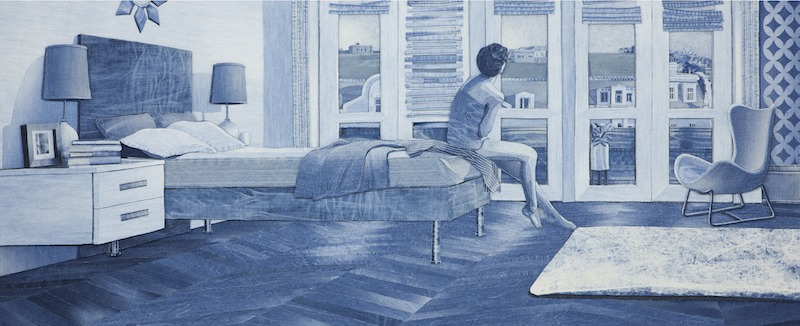
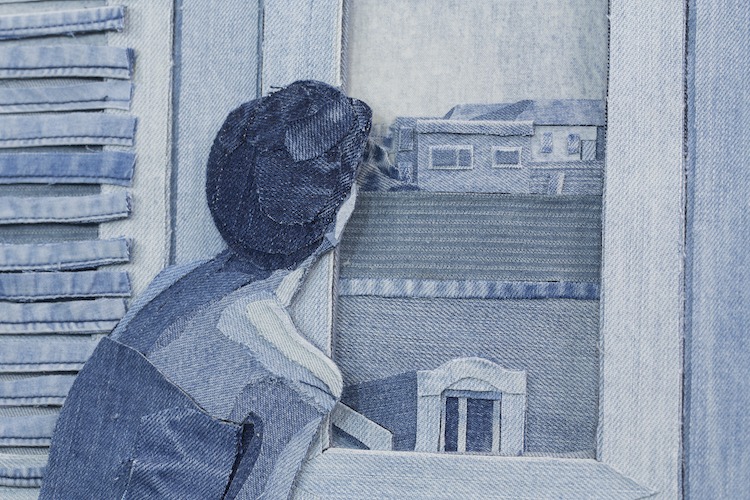
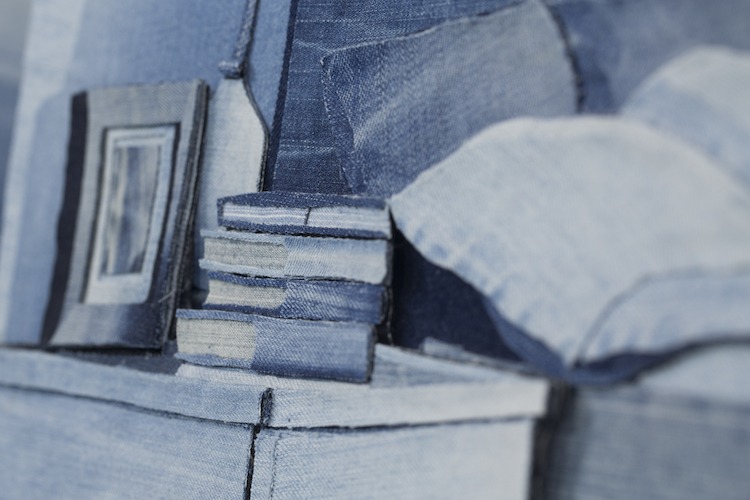
The pressures of living in a city like this, and seeing the rising property prices, cranes everywhere yet seeing important community areas closing was quite disheartening and disturbing. Seeing apartments left empty as they were sold to someone in an auction to someone in Hong Kong is wrong, and should be outlawed.
I started to see the property as a burden, as well as the way we perceive other people by the home and other material possessions. So quite often the work depicts quite beautiful homes, fit for an airbrushed interior design magazine that appeals to our aspirations yet showing an isolated figure not seen in said magazines showing that perhaps these are really not the things that make us happy.
The sister show in the separate gallery space is all on the laundrette, and while on the surface it may seem so different other than the lonely sole, they are connected as I feel places that have been the heart of the community are closing down. the fabric (not intended) of our communities is changing, and I am finding that we are becoming so disconnected to other real people as our lives go online and the 24-hour news takes over.
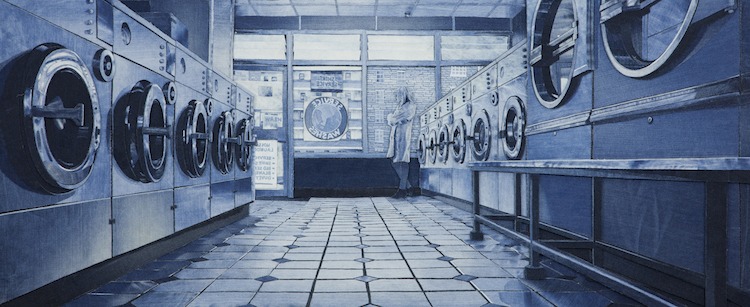
The best day of my life
What was your route to becoming an artist?
Not the normal one, but also the route of many of my favourite artists.
I was a kid who always wanted to create, but living in a northern town I listened to the quite sensible voices of ‘there is no career in art’ so I ended up going down the commercial art route, being an art director in advertising. I started doing the work in denim on the side, experimenting and mainly doing it to be creative outside of work.
People started to notice, and I wanted to keep pushing my technique. I moved to Australia after working in London and then was in advertising in Sydney, but I hated the job. It got in the way of making the art, was dull briefs and working during the financial crisis was tough.
I was the last one to be made redundant and on that day, I remember walking out on the street and shouting ‘I am F’ing free’ to my Aussie cousin on the phone, who informed me he had put me on speaker and my mum and dad were with him. Of course, they worried, but it was the best day of my life and the biggest turning point, and I knew it then.
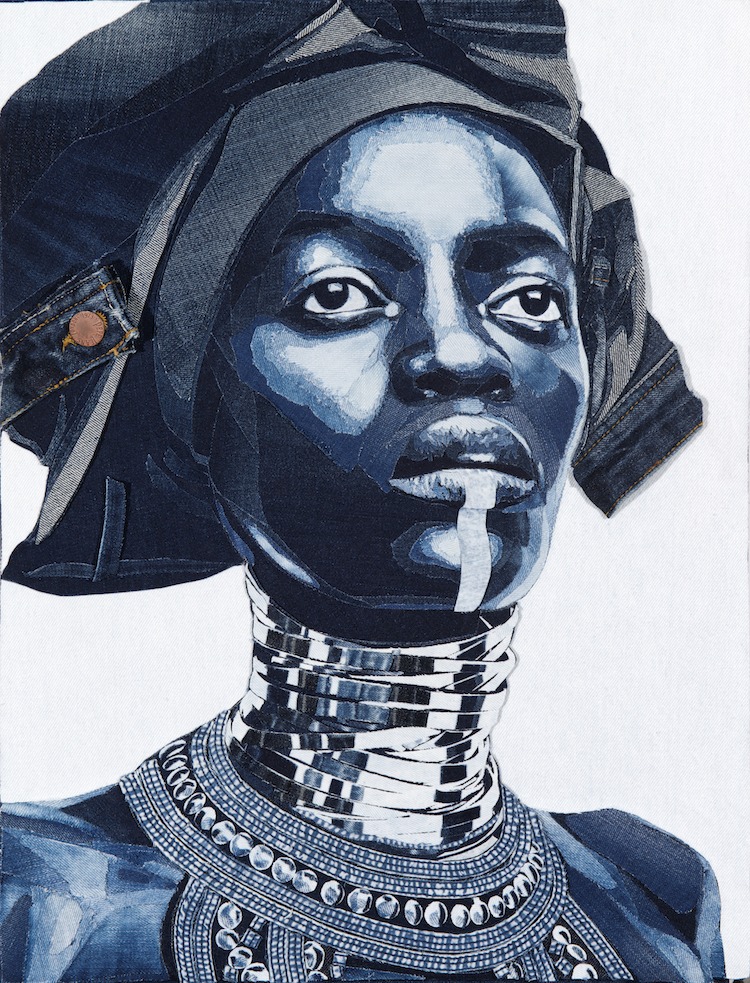
I had saved up some money, so decided to go some time creating the work, put a collection together and, something I will say before this comes a biblical size essay, is that all the things that has happened to help me become a working artist has been from other artists and their help and recommendations. And I think many forget that it’s a tough world and a hard business to be in, we all should help each other. I came across many who were so hidden and wouldn’t – and they are all in the same positions they were and it’s quite sad really.
But the work is time-consuming, and almost it feels like the last decade has flashed by without really taking stock. It takes great dedication and sacrifice often.
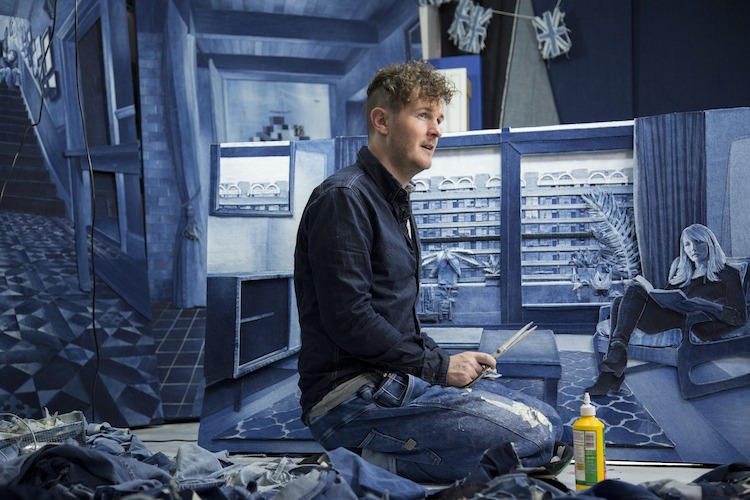
Creating the illusion
Tell us a bit about your chosen techniques.
Sadly with most people seeing my work on mobile tech, you can’t see the benefit of the technique. I’m aware that making my work in only denim could be a gimmick and yes, when I started out in some ways that helped with some of the ‘tadaaaa’ media. While it has led to some opportunities, if I could go back I would change that. I don’t think all press is good press.
But my work now isn’t really about it being made with denim, I love that it is the material of our time and I am depicting our lives but it doesn’t dictate the piece. It’s just my paint.
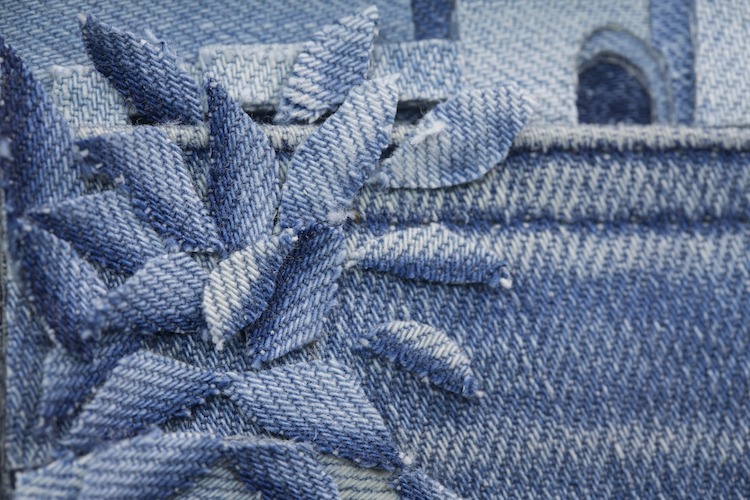
I think the thing that nobody sees online, as they are shrunk so much, is that every little piece has a wash in it, or, a fade. For example like the cat’s whiskers, the lines from the crotch to pocket, or like when you open the hem. It can take hours to find the right bit, but it is worth it as it helps to create the illusion that it is a painting. These gradients are almost what my technique is all about. Even in real life, people think it isn’t denim until centimeters away.
Another thing lost online is I layer the pieces up, I was just with the gallery and counted with them the layers of the door on the washing machine, there was 14. This makes them very three dimensional – so lighting can be crucial.
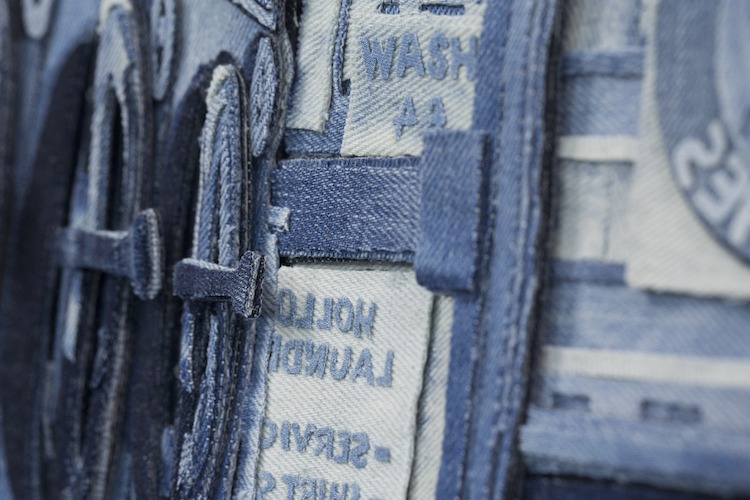
My medium choice is also important, now with so many pairs of jeans, coming from donations all over the world, neighbours leaving bags outside my door as well as Pepe Jeans London sending me many. I use the washes and fades in the denim to create my work and it is connecting each piece that really has pushed my work further and further in skill. If you were to look at any piece of mine, each piece, even the smallest, will be cut out of the gradient of the shade within a pair of jeans. It is what helps create that painterly look.
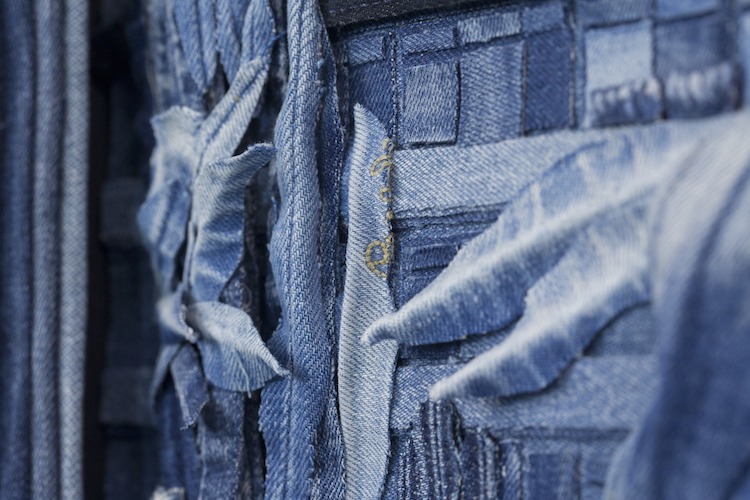
A final technique I will mention, here I won’t bore saying I use scissors and cut but try and find something different to say, is that I have also got to acknowledge the direction of the warp and weft to follow those lines and the direction the texture of denim is in, which again all adds up to the time-consuming process
On the fringes
How would you describe your work and where do you think it fits within the sphere of contemporary art?
It is a very good question. I feel I straddle many worlds, but don’t fully sit in any. For starters, I have really never felt I sit in naturally with textile art, although I would like to. I know many cool quilters, but mine is not quilting. I would love to be more a part of this genre and meet others working with it especially here in London where I just moved back to, most the people I know are in the states and continental Europe. It’s always good to meet like minded people. Normally we find we have the same issues and we help ourselves feel less mad.
I have been quite involved with the denim world too, but again, I’m on the fringes of that as doing something so different to others and think I look at it much different to them. Many people think I am a denim geek, but put me in a room full of denim geeks and I soon get found out! But for me, while I am probably an expert on many parts of the denim, the thing that interests me about denim is you need not be an expert to enjoy and wear it – making it the most democratic fabric there is.
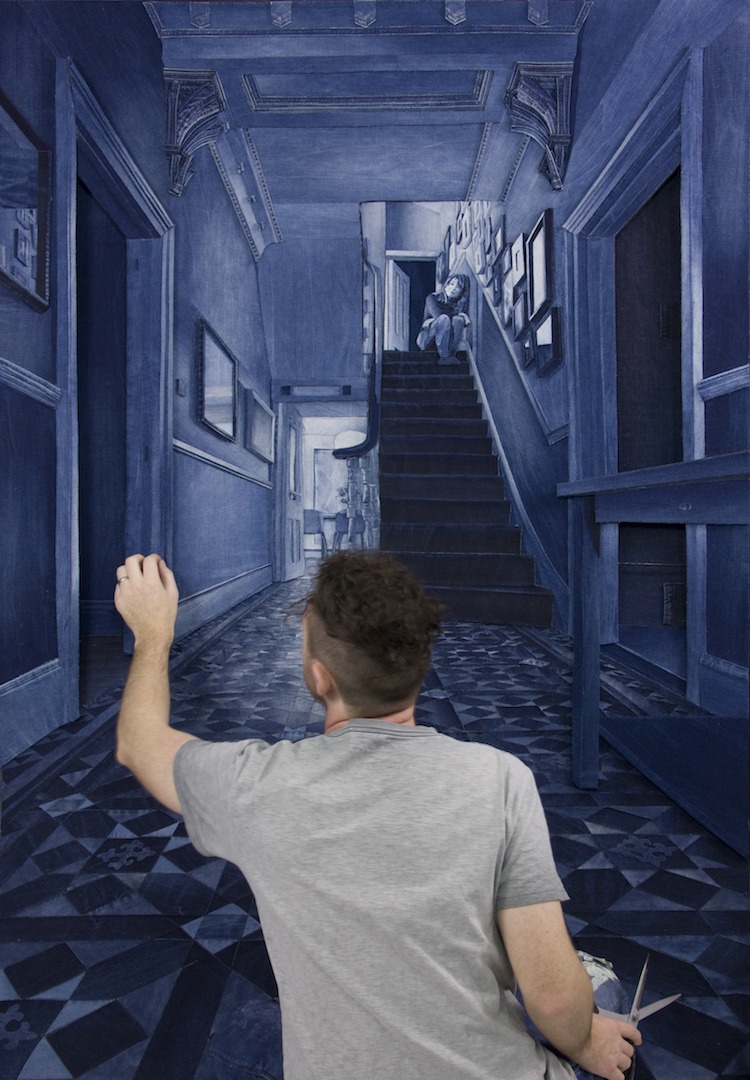
As mentioned I like and follow many of the street artists, and also I quite like the American lowbrow movement. But I don’t really fit in there always, in fact, if I am ever at art fairs, it’s not always easy to hang my work next to others.
As for describing my work, I often find others are so much better at that than I. I think there is a reason I stay in the studio and create and then show my work as perhaps I find it easier to communicate that way. I think this year more than most, I see what is going on, it’s what I want to depict – and what better material to capture the many layers of urban life than with the material that I think is the symbol of our time with all its dualities and conflicting meanings. I’m pretty useless with words and will often use many where only a few will do.
I depict the many layers of urban living with the urbanist fabric there is (from rural beginnings) looking at the things we see every day but don’t really look at, by connecting a visual we see every day with a material we see and wear every day, we re-look at something and hopefully people can have a connection.
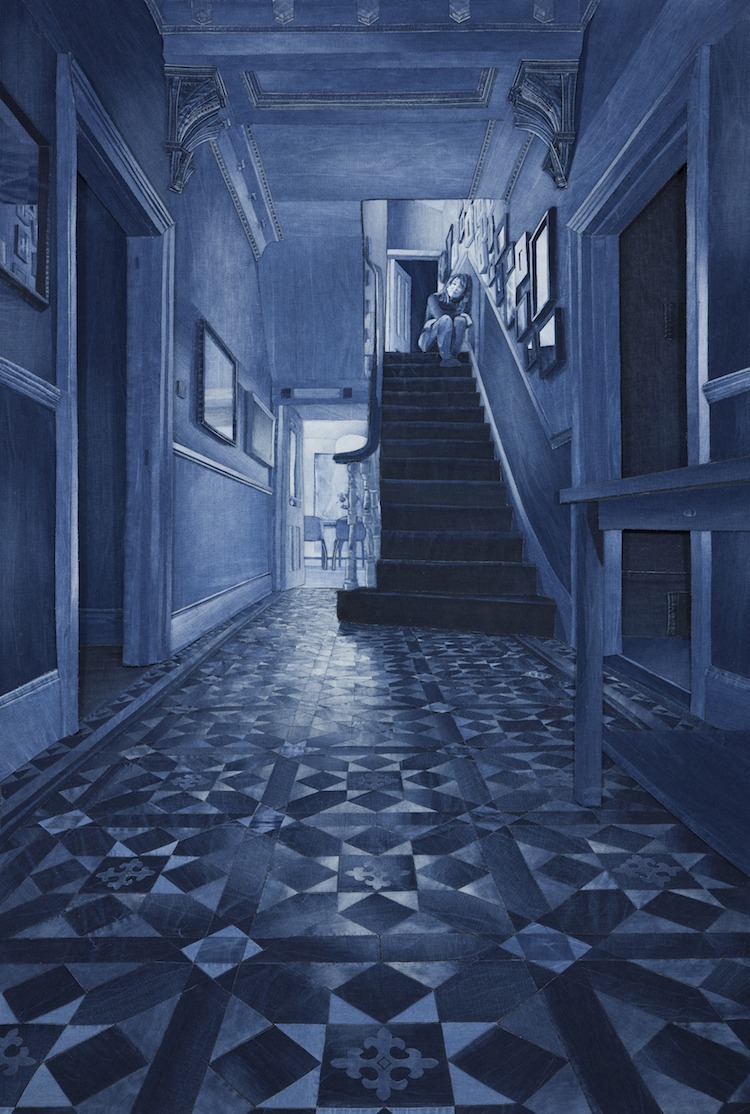
A denim dream
Do you use a sketchbook? If not, what preparatory work do you do?
I used to but more so I work from photographs, setting up scenes and shooting them to work from. I would say there are 100 photos to every pieces I work on, as sadly they take so long, so many ideas don’t get created. When people ask how long the pieces take, I often forget about the process of preparing the piece that can take as long as creating it.
What environment do you like to work in?
I think that may be answered with changing the wording of the question, as perhaps what I like to work in and what I do work in may be quite different. It looks like a denim dream to some, an organised mess to others and to some, chaos.
My studio has a couple of thousand pairs of jeans in it, supposedly all organised by shade. While the studio is big, in a converted warehouse in East London, having that many pairs of jeans suddenly makes it a lot smaller so sometimes it can feel quite claustrophobic especially when working on the bigger pieces.
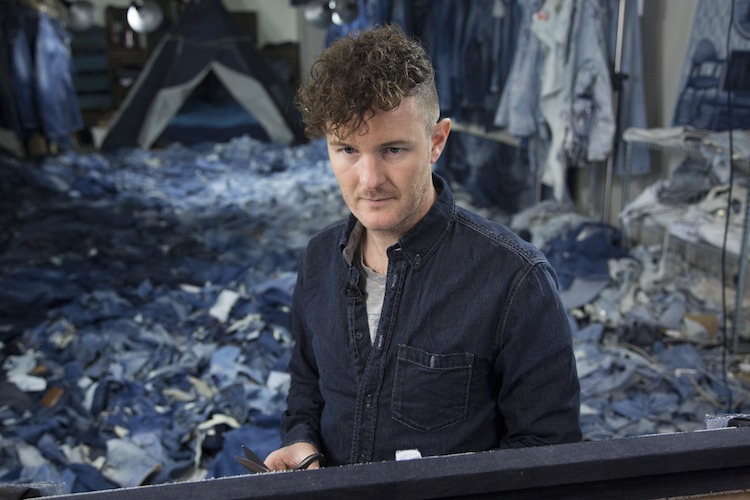
Many who know me wouldn’t believe it to be true, but I hate mess and clutter. Often between pieces I really need a good tidy up, it helps tidy up my brain too. I cannot do it midpiece though, as often need the denim that I have worked with handy for other parts of the piece for consistency.
We recently filmed in the studio and the film guys started moving jeans for effect, and I took a week to get my bearings again. I know where things are, and it was worse as I was midpiece so had to find denim similar to what I was using.
Sadly I prefer to work late at night. Not great when you have a little boy who wants to wake early.
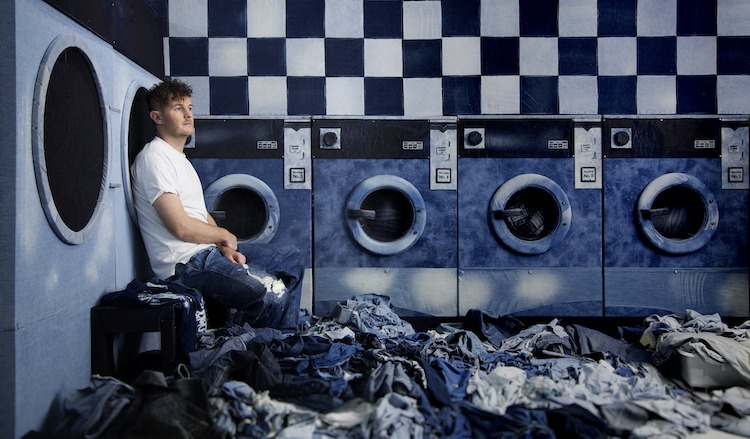
Who have been your major influences and why?
It seems quite strange to admit it now looking back because of how big they have become, but I would say many other street artists that really came to light in the early 2000’s. When I moved to London, for the first time over ten years ago, I was exposed to so much more street art and good, amazing work. It all had that attitude of I can do what I want and I don’t care where I come from. It motivated me to get back into art. I was training, then working as an art director in advertising at the beginning and then started to work with my art in the evenings and weekends, which, if you know advertising, is not easy.
I actually think training and working in advertising actual helped in many ways, it was a mainly conceptual course and some of the people I was with, and then worked with, had wonderful creative minds – and quick ones. While what normally gets put out is garbage, often that is for other reasons. In many of my previous work you can see a graphic design element, like in the news stand installation.
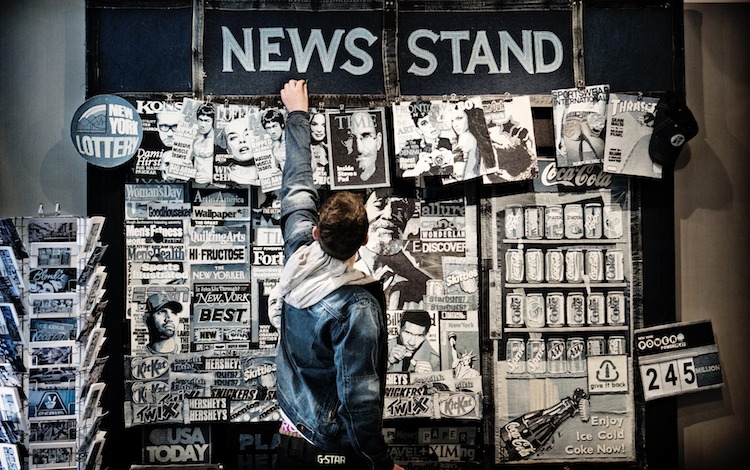
I had previously mentioned Hockney, but I can get it from a lot of sources. Now other people creating in textile art is, but often I really like seeing people using unusual material, not just textile.
There is a fine line between gimmick and brilliant, but as said Mark Evans falls into the latter category then seeing the things Vik Muniz does, Vhils and I thought the Jonathan Yeo porn magazine portraits were so well done.
Tell us about a piece of your work that holds particularly fond memories and why?
As it comes after the above question and I’m thinking of the early days, quite a sweet one to do was when I got asked to do the Debbie Harry portrait a couple of years ago. One, as I really love the denim story and she and all that went on at the Bowery, helping spawn the punk era that came to London with Malcolm Maclaren, was important to me.
I normally turn down commission portraits unless they have a connection to denim and she was one of the first people known for wearing double denim.
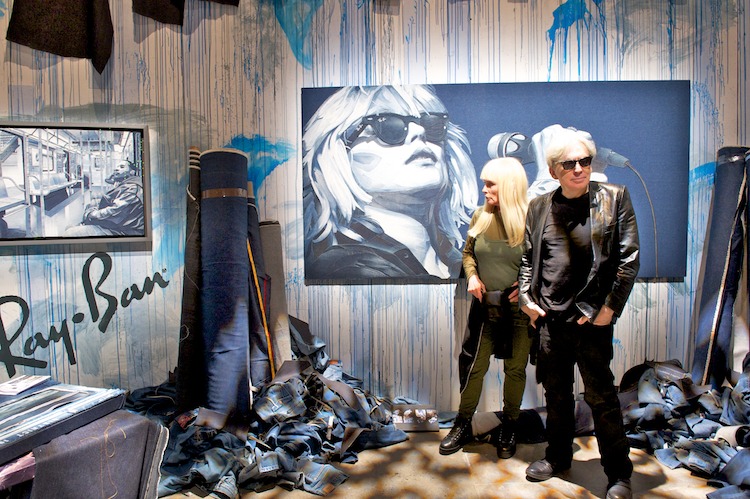
However it was sweet as in that small bedroom I had many years ago, the first piece I ever did in denim was of Debbie Harry. I think if I had had time to think on that, it would have been quite special to think how far it had come.
That said, I think the body of work I have just done with Behind Closed Doors has been very special to me and I have been amazed over this last year how many people will open up and talk about things when viewing them. For me, it has been the most personal body of work I have done, even though I have not depicted myself. It has been a hard few years.
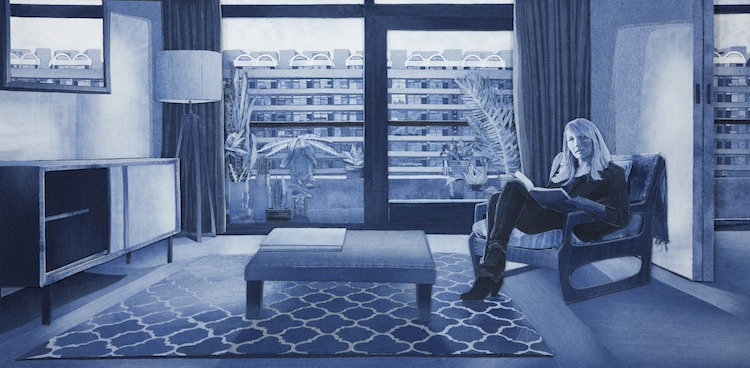
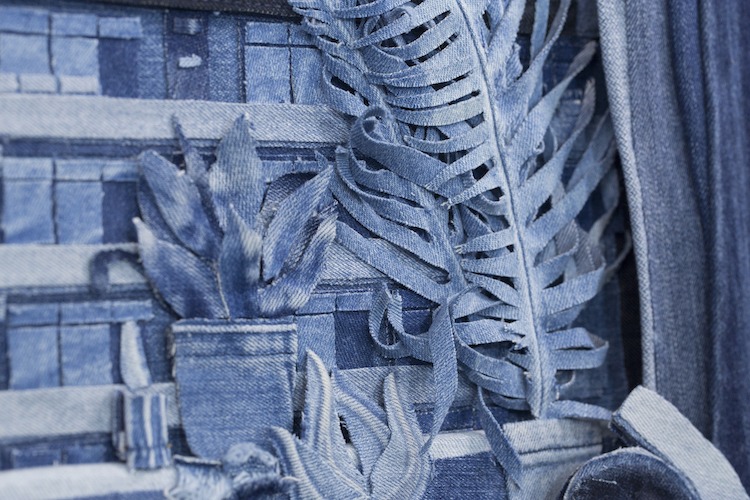
Find your passion
How has your work developed since you began and how do you see it evolving in the future?
I am learning everyday new ways of using the denim and how to keep pushing it, and this excites me and keeps me going. I often get asked if I would ever use another material and I very much doubt it as I love to push the medium to see how much I achieve with it. I actually thought I would go quite abstract with it, however I found myself drawn to see how photorealistic I could make the pieces challenging myself all the time.
Sometimes this backfires as people don’t realise it is denim. While that is the aim, it is pretty rewarding to see some people’s reaction when they do realise it is denim. Not all do and go away believing it is a painting or photograph.
I remember being in a restaurant near my gallery and I heard someone come in and say to another, ‘have you seen those amazing blue paintings in the gallery window’ the other person says ‘yes, I can’t believe it’s all made from denim. I smiled to myself to see the original person’s jaw drop.
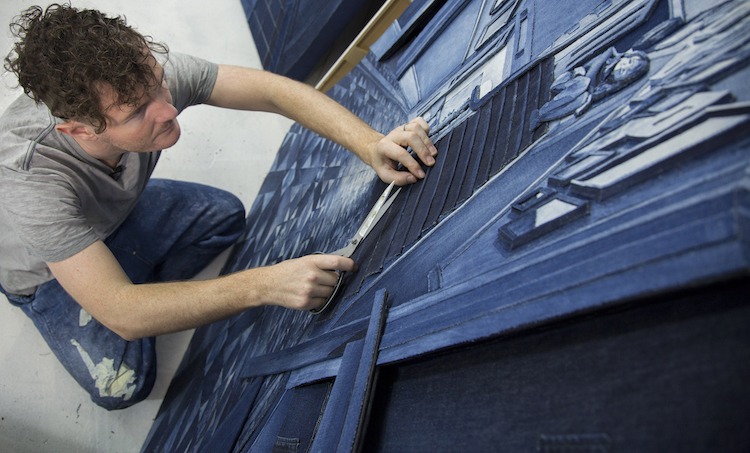
But it is not just the technique I want to fully master, but the ideas in the work. I have been really moved by working with Behind Closed Doors and would like to build on it. I will work on larger canvases, which brings its own challenges to creating, my palette is only limited to the jeans I get. I cannot mix some paint, as well as restrictions with the size of jeans, and really want to explore issues with our world and my world, all with the material we all wear, and most of us, feel comfortable with.
This body of work especially, I have done what I want to do, and obviously, I do care if others like it, but really – I like it and believe in it, and that should count for something.
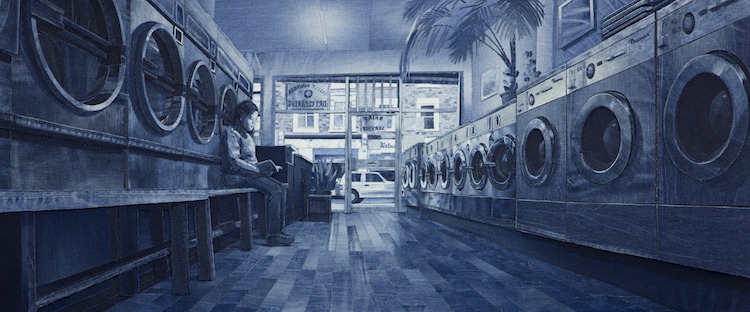
What advice would you give to an aspiring textile artist?
I know I heard Grayson Perry lately say he hated the word passion, but I don’t agree, unless he is meaning who say they have passion, but don’t. Find something you find a passion for, it doesn’t feel it is a job, although you need to be professional. It isn’t easy, but nothing worth doing is but if you find something you love doing, it makes it worth getting out of bed for, even if you got into it a few hours before.
I would say my greatest work has been the ones that the observer has seen that I enjoyed doing, as the confidence comes through. I think most textile art is quite detailed and time-consuming, mine certainly is, and to be patient with that kind of work, you need to focus often and prioritise where you want to get to with it – sadly you have to make sacrifices. Sadly I see many people talking a good game, without putting the action in.
All that and read TextileArtist.org of course!
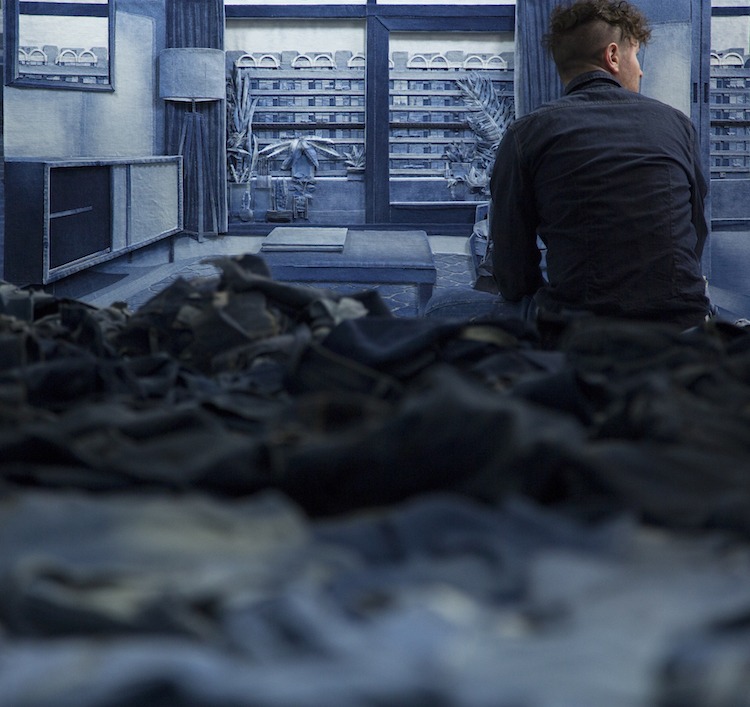
Can you recommend 3 or 4 books for textile artists?
(he quickly looks at is extensive book collection..)
[easyazon_link identifier=”B01K0PZ8W4″ locale=”UK” tag=”wwwtextileart-21″]By Hand: The Use of Craft in Contemporary Art by Shu Hung and Joseph Magliaro is a compact book that I really enjoyed flicking through and shows quite conceptual ways artists use fabric.
I discovered many new artists in [easyazon_link identifier=”1906155291″ locale=”UK” tag=”wwwtextileart-21″]Contemporary Textiles by Black Dog Publishing. There was some I didn’t previously know, like Mike Kelley a few years ago when I got the book.
Any Grayson Perry book is good for me for the social commentary. And finally, while not strictly textiles, I did like the [easyazon_link identifier=”B00MMPP6TG” locale=”UK” tag=”wwwtextileart-21″]40 under 40 Craft Futures by Renwick Yale.
What other resources do you use? Blogs, websites, magazines etc.
I’ve been trying to be offline as much as possible to be honest, but as well TextileArtist.org, I look at Juxtapoz and Hi-Fructose magazines. I’ve been lucky enough to have good communications with magazines such as Burda, Textile Plus and Handwerken Zonder Grenzen but a lot of the time, I am looking at general news and sadly been following too much of world news and politics lately.
What piece of equipment or tool could you not live without?
An obvious one, my scissors. Normally have to buy a new pair every month.
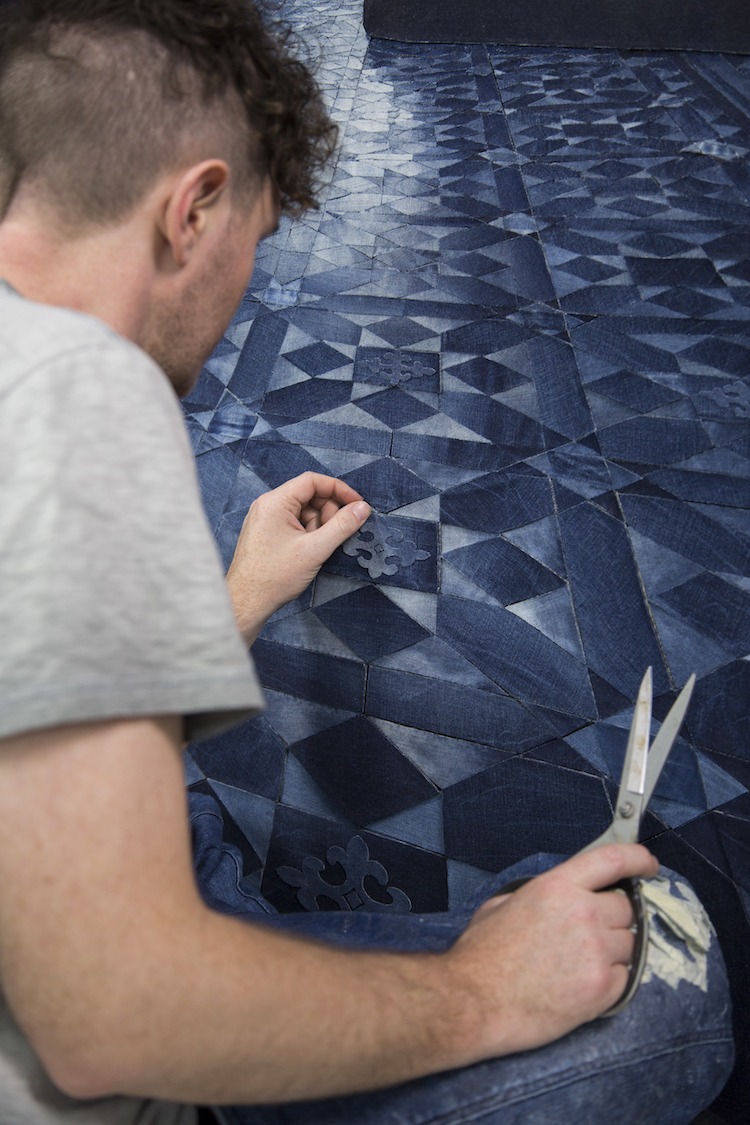
Feeding off people’s reactions
Do you give talks or run workshops or classes? If so where can readers find information about these?
I have actually done more with kids with this. As I was an artist who got put off art until late teens I have always wanted to show children that it is possible. They also seem to find the work fun, and can all bring old jeans in.
I haven’t done so many talks in the context which I think you are meaning, specifically on a textile art angle – but next year I will be at the European Patchwork Meeting and Quilt en Sud in Biarritz.
How do you go about choosing where to show your work?
For me this has been a rather difficult one as a massive positive for me has also led to being a negative. My gallery has always given me a really good solo show, but often the work sells out before the doors open. As the work is so time-consuming, you can disappear for a long time. I end up having to turn down so much, or saying yes to things and living without sleep for a long period of time. I have missed things like showing in some other countries and often have to say no to show at fairs.

But I should consider myself grateful that this way helps me live and work as an artist and has done now for quite a few years. With my work being something that you have to really see to understand, I do feed off seeing people’s reactions to the work and that has never been something I have felt online or in secondary sources.

After the last show, I got something perhaps that should be called empty studio syndrome. After the studio had been so full of work, and being surrounded by your own work can be inspiring, the studio felt so empty, and after the high, strangely I lost confidence I could do it and had little reference of the work I did.
So the lesson to be learned is when preparing for a show, start another piece before it opens so you can come back and carry on in the routine of working
The ones in the UK this month can see Behind Closed Doors and My Beautiful Laundrette with Catto Gallery at 15 Percy Street in Fitzrovia until the 30th November. There will also be installations – one depicting a typical interior design/home furnishings style window, showing the aspiration compared to more the reality inside the gallery and in My Beautiful Launderette, anyone can come and walk into a soon to be closing down laundrette – all made lifesize in denim.
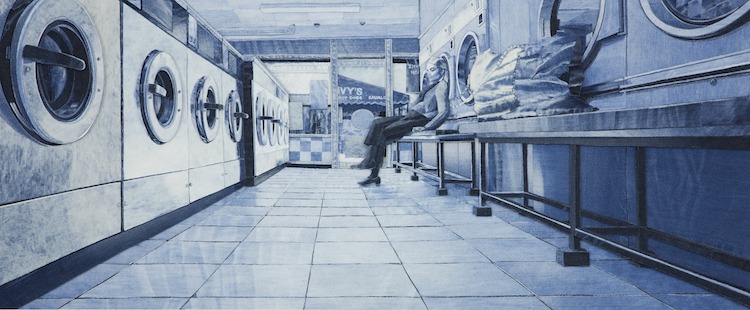
Then I will be showing later in the month at the Being a Man Festival at the South Bank Centre, with the charity I work with, Calm.
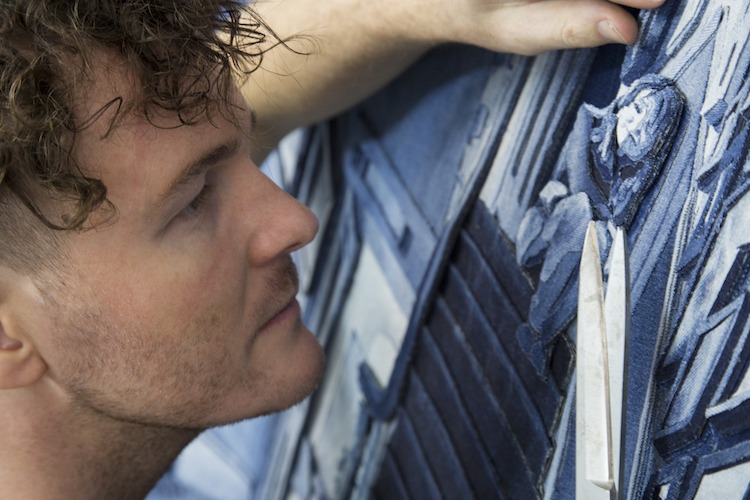
For more information visit: www.ianberry.org
Let your friends know about this artist’s work by sharing the article on social media. It’s easy – click on the buttons below!
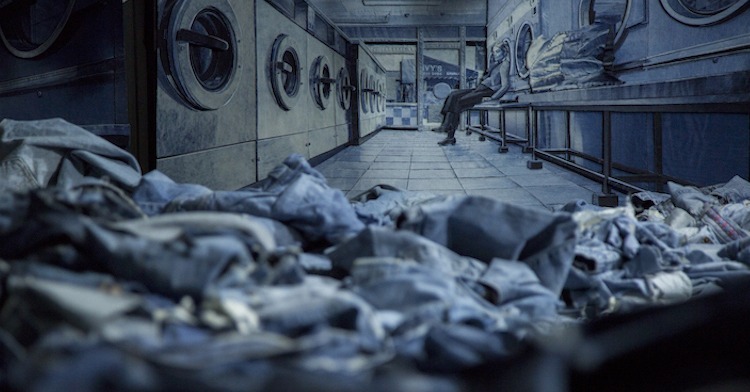
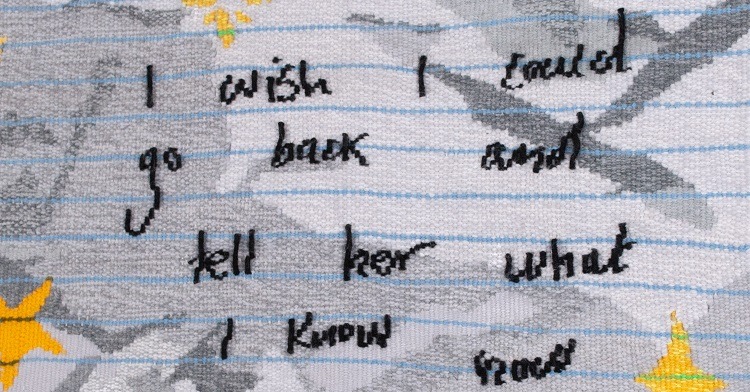
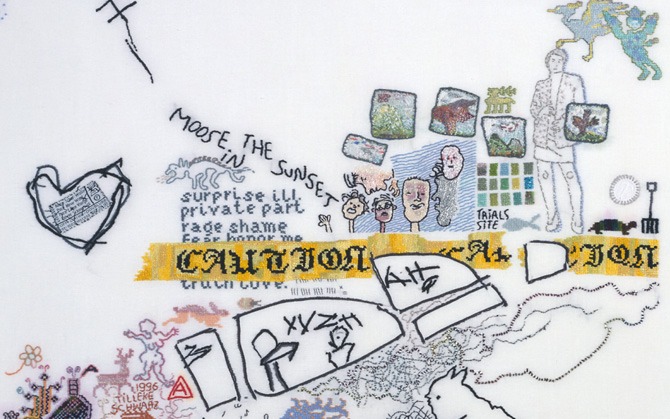
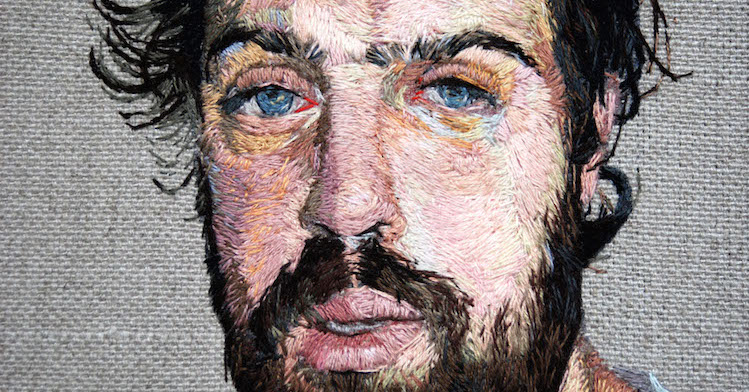
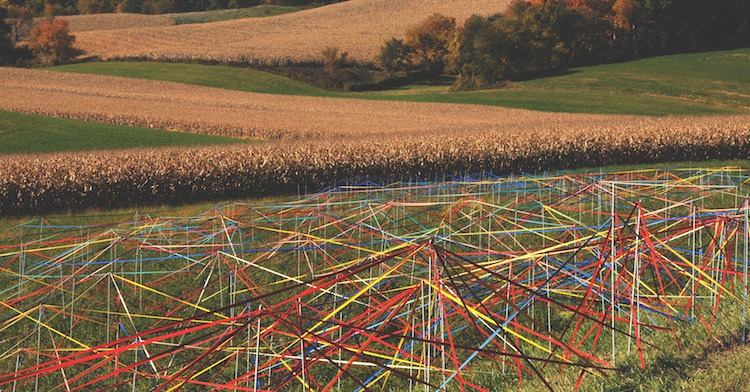
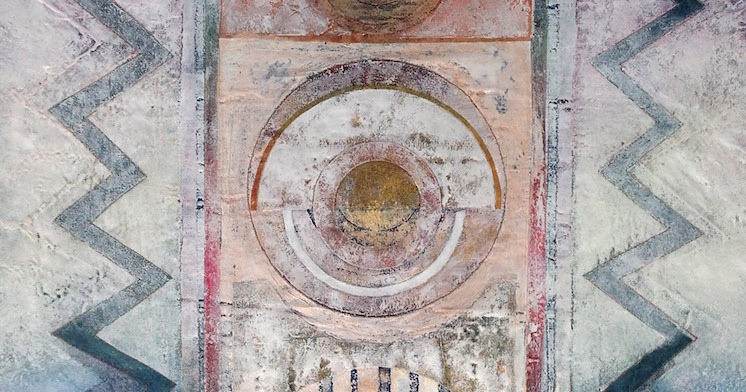
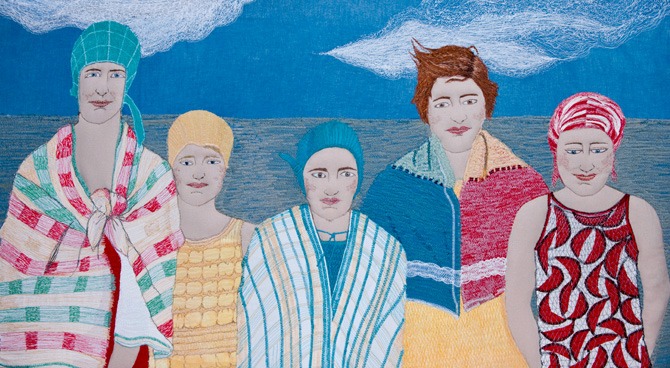
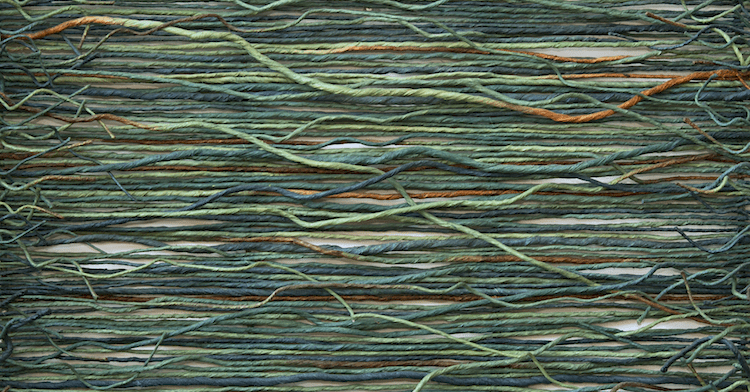
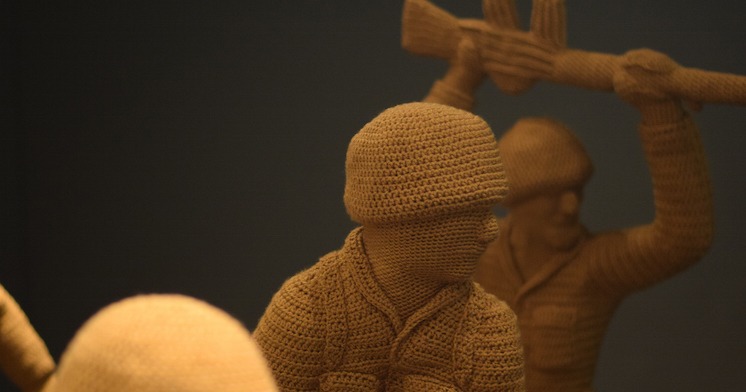
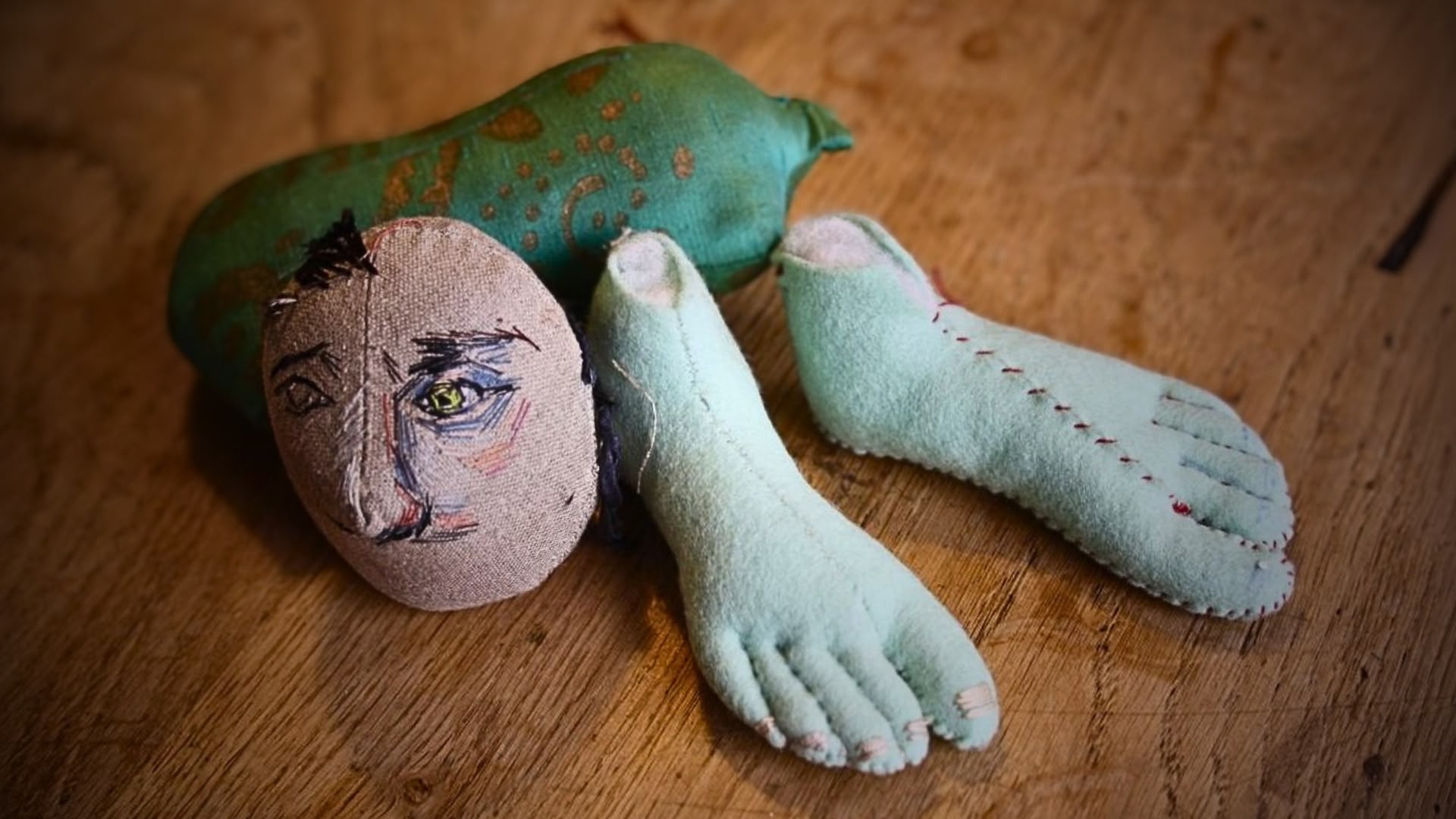
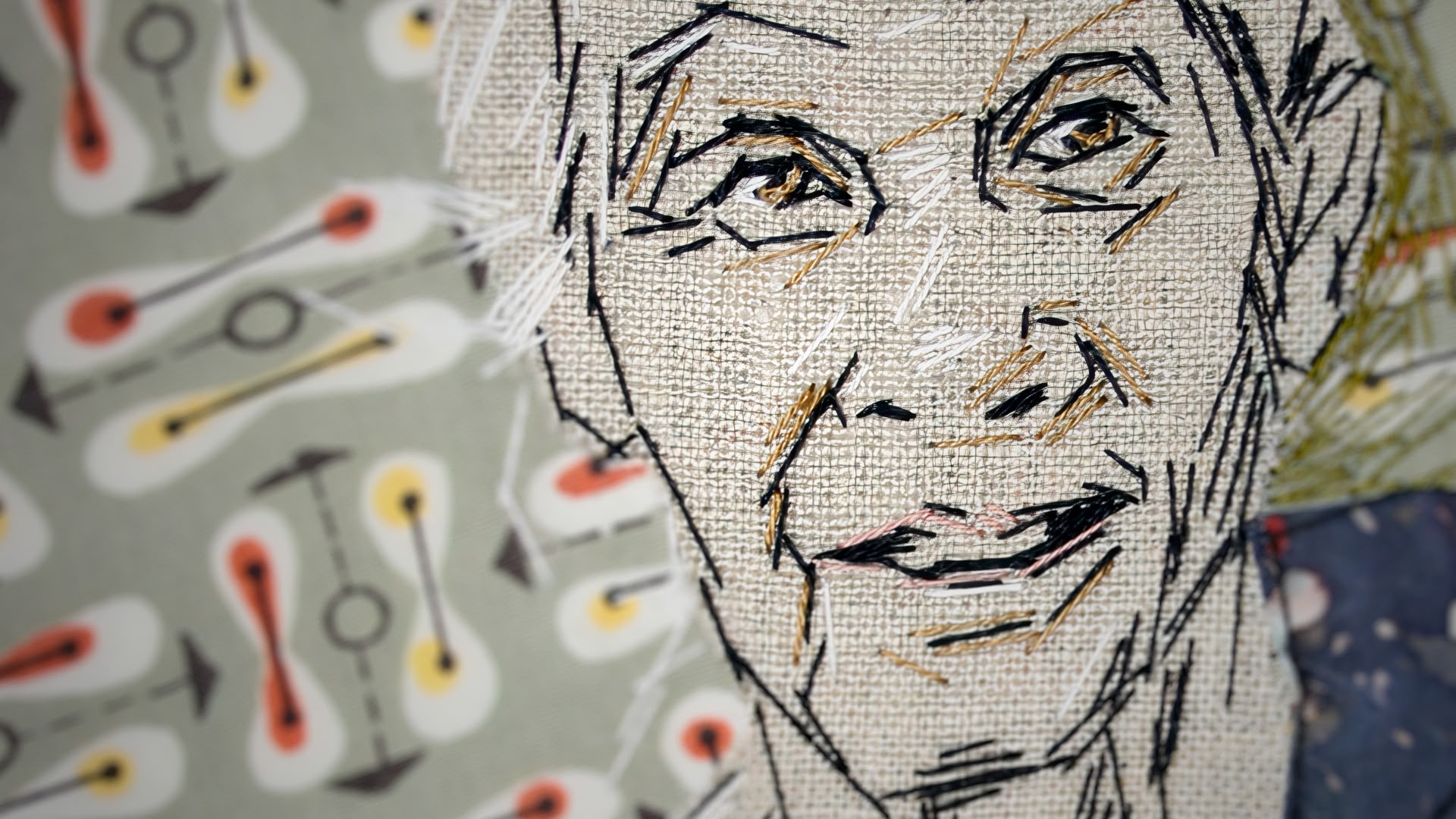
8 comments
Betty rowley
Amazing work. You have so much dedication and passion for your work.
Thank you for your article. I will look for more of your work.
Diane
Just love this detailed work!
Nicola Basham
Wow Ian, your ideas, skill and techniques are breath taking and thought provoking…on such a big scale too….brillliant. I will really think about your work in relation to my “normal” materials if willow and cane. Thank you.
Aly
How does the artist assemble the pieces? Are they sewn or glued together?
Terri-ann Broomes
love your work Ian
Brenda Herbst
You are a great inspiration!
My sister had introduced me to her “Freestyle” embroidery group of Knoxville when I would visit from Florida. When I retired in 2013 I joined their group. I’ve learned a lot but still learning everyday.
Best of luck and may God continue to bless you.
Brenda
Linda Brown
Beautiful work! and great article. I wish you the best of luck-
Ian Berry
Thank you Linda.